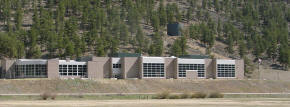Mr. Ghist's Science Page
Platte Canyon High
School
Bailey, Colorado

SCIENCE
STANDARDS
4
|
Mr. Ghist's Science Page |
Platte Canyon High
School |
|
 |
SCIENCE
STANDARDS |
|
| ================================================== | ||
Students know and understand the processes and interactions of Earth's systems and the structure and dynamics of Earth and other objects in space.
|
BENCHMARKS: 4.1 Students
know and understand the composition of Earth, its history, and the natural
processes that shape it.
4.2 Students
know and understand the general characteristics of the atmosphere and
fundamental processes of weather.
4.3 Students
know major sources of water, its uses, importance, and cyclic patterns of
movement through the environment
4.4 Students
know the structure of the solar system, composition and interactions of
objects in the universe, and how space is explored.
|
| GRADE LEVEL
EXPECTATIONS:
Guiding
questions: ∑
What
is the physical earth made of and how do we describe them? ∑
What
processes and interactions change the earth over time? ∑
Where
is water found on the earth, what are itís characteristics, and how does
it move? ∑
What
causes different kinds of weather and the seasons and how does it change
overtime? ∑
What
is the earthís place in the solar system, galaxy, and universe? Expectations: describe
the composition and structure of the Earth's interior use
the theory of plate tectonics to explain the relationships among
earthquakes, volcanoes, mid ocean ridges, and deep sea trenches use
evidence to investigate how the Earth has changed or remained constant
over short and long periods of time evaluate
the feasibility of predicting and controlling natural events analyze
the costs, benefits, and consequences of natural resource exploration,
development and consumption know
that energy enters the Earth system primarily as solar radiation and
eventually escapes as heat know
that climate (in the long run) and weather (in the short run) involve the
transfer of energy in and out of the atmosphere investigate
factors that influence water quality explain
the water cycle in terms of how water circulates through the biosphere,
lithosphere, and atmosphere analyze
the structure and evolution of the atmosphere and its significance to life describe
the structure of-the solar system and forces within as well as beyond the
system (e.g. gravity and centrifugal force) describe
electromagnetic radiation produced by the sun and other stars know that stars differ in their life cycles, and visual, radio, and x-ray telescopes collect data that reveal these differences |
| ================================================= |